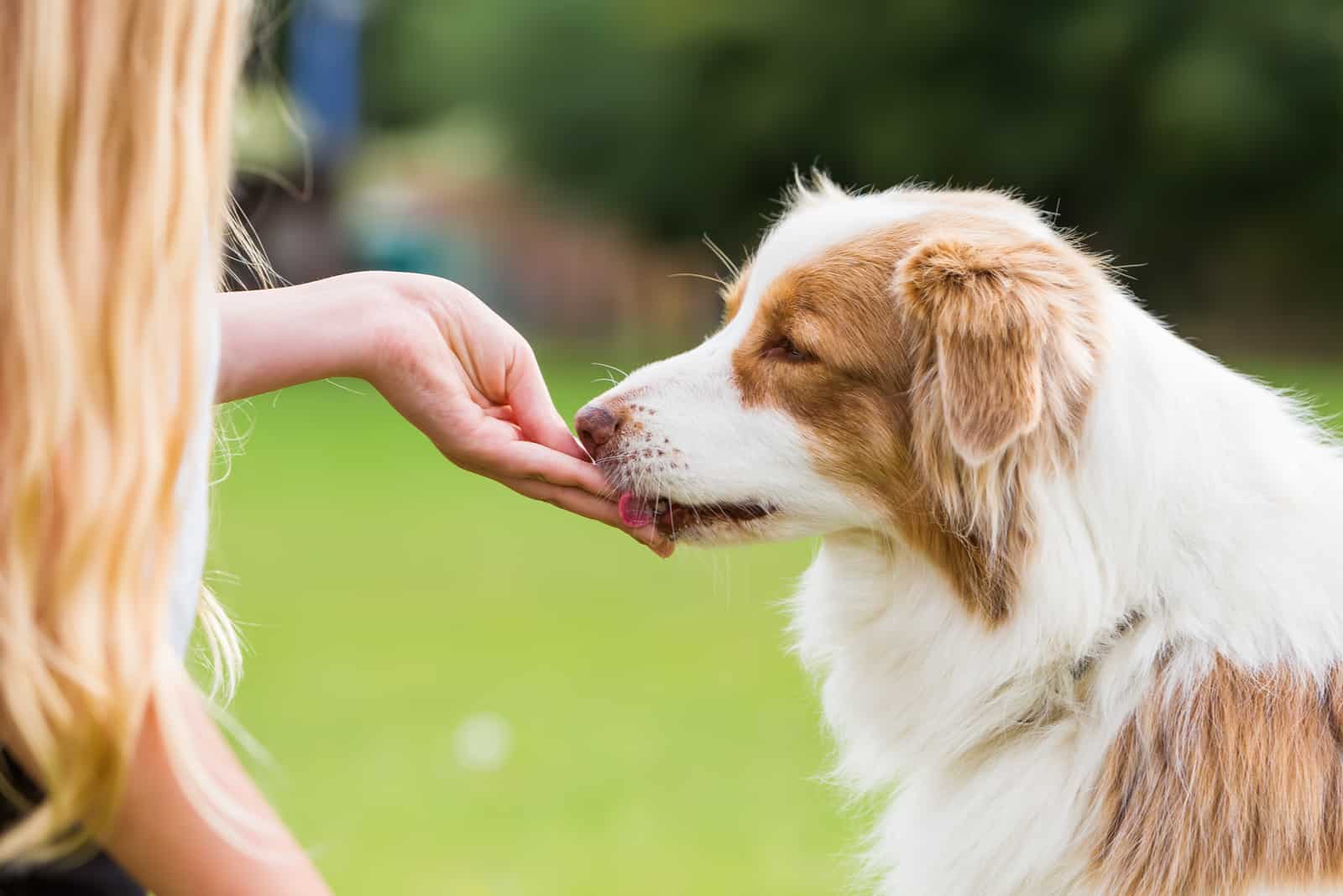Every dog owner wants his dog to be happy and healthy. Of course, that’s not always possible. Our canine buddies may exhibit unusual behavior that can be linked to health problems.
One of those uncommon behavioral patterns is hunger strike, or so called partial anorexia.
I bet none of you have encountered this before!
So, how do you react in such a situation? What should be done if your dog won’t eat his food, but will eat treats instead? Is this some kind of picky eater behavior, or is Fido seriously ill?
Well, the truth is that all scenarios are possible.
Usually, dogs will have some health issues that will bother them so much that they begin to refuse meals.
Still, why do puppies choose treats instead?
I like to say that puppies have found a so-called connection between getting treats and feeling happy. It’s really that simple. Once you give your dog a delicious treat, he will be thrilled, and he will want more just because it doesn’t happen quite often.
As a dog owner, you will need to put your foot down and say when is enough with the treats. Proper feeding habits should be introduced to your dog.
Now, I know teaching puppies to eat healthy is simple, but teaching adult doggos is very hard. They already know what they want because they have tried other things and they already have their preferences.
Well, today, I will try to explain to you all the reasons behind a meal strike and picking treats over it. Also, I’ll do my best to help you solve this issue before it’s too late.
If your dog won’t eat his food, but will eat treats, and you find that beyond annoying, this article is just for you!
Why Is My Dog Eating Treats Instead Of Meals?
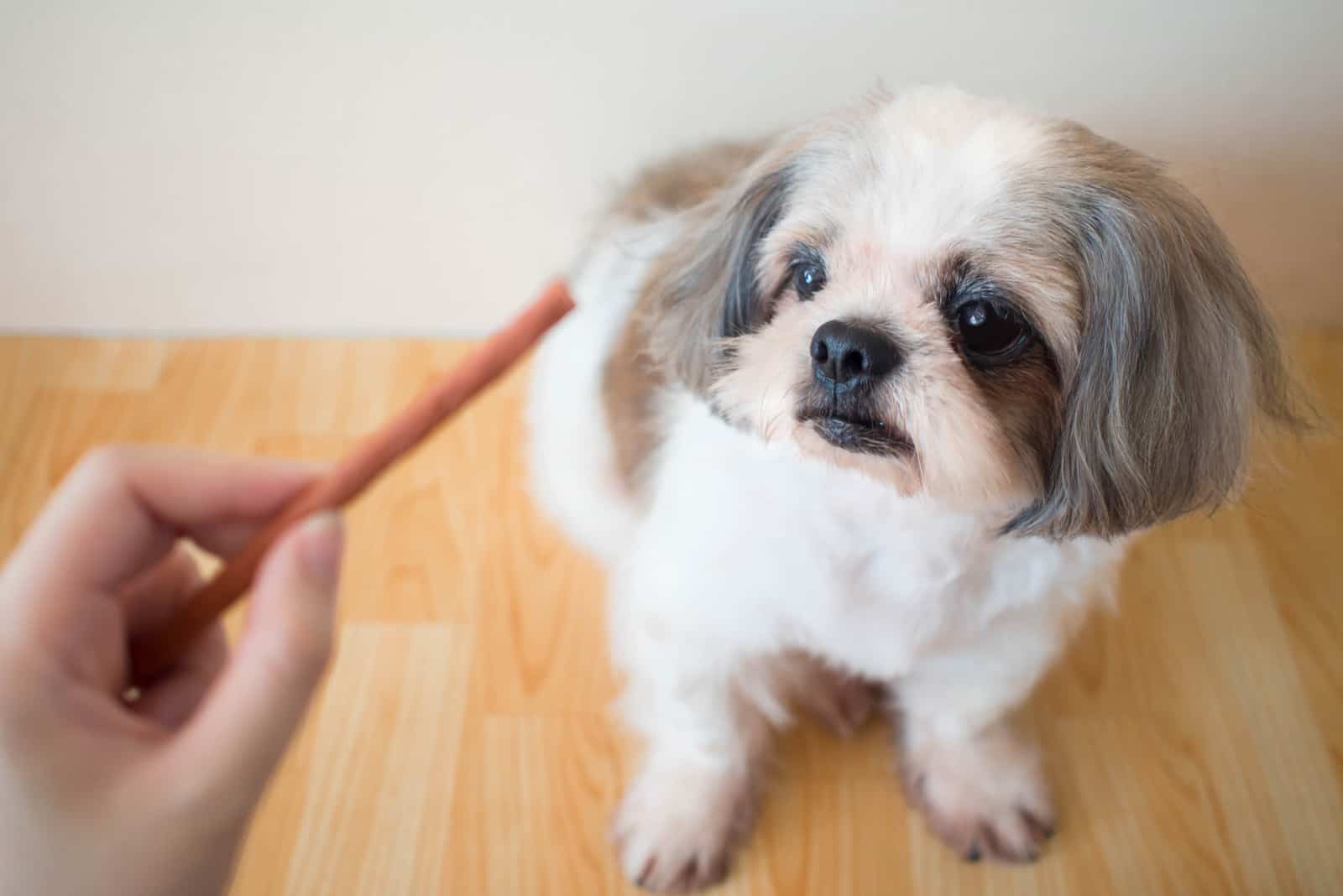
There comes a time in every dog’s life when she begins to refuse food for some reason. But, a worried owner might find himself puzzled once he sees that his dog is eating everything but her food – mostly dog treats and other snacks.
Truth be told, feeding your dog treats is an unhealthy practice. Adult dogs should have mealtime twice a day. Usually, dogs like to have a so-called breakfast and dinner. There’s really no need for food in between. Still, I understand that you want to reward your pup from time to time.
However, real problems arise when the pup starts choosing treats and snacks over proper meals.
What’s happening with that dog? Why are treats so much yummier than real food?
Well, there are many reasons behind such behavior. We can divide them all into health conditions and psychological reasons. None of them are harmless. Each reason behind refusing food and picking treats over it should be addressed and treated.
Now, we’re going to address the psychological reasons as to why a dog won’t eat his food, but will eat treats. Let’s say they’re not as severe as some medical conditions that prevent dogs from eating properly.
Psychological Reasons Behind A Hunger Strike
Whether you like it or not, dogs are sensitive creatures. They may act all tough like Dobermans or Rottweilers, but even they can sense something’s wrong and let their mood be affected by it.
Dogs feel things just like humans. You can’t expect them to be cold as a rock. They have emotions, and most often, emotions can affect a dog’s overall condition.
The biggest reason behind hunger strikes and picking treats over meals is stress. In fact, stress is the #1 reason behind a vast majority of health issues. Sadly, no matter how hard we try, sometimes it’s very hard to prevent stressful situations in your dog’s environment.
Frankly, dogs find some situations stressful, even though they seem perfectly fine to we humans. We’re not all the same. Different life events like moving to another home, or even picking out a new dog bed may be stress triggers.
Those are some minor life events. But, what about bringing a new baby into the family or someone passing away? Those are even more stressful, especially if the dog was attached to the late family member.
My good friend, Jake, told me that his uncle had passed away recently. He left a family of four behind him, including four tiny paws – a Shih Tzu pup of seven years.
He was tightly attached to the uncle, and started refusing meals for a while. The only thing the dog cared about were his treats – the exact bag of treats that the uncle used to feed the dog.
And, tell me dogs don’t sense things!
Even the slightest change in your schedule may trigger a change in your dog’s behavior in terms of eating his meals. If you can, try sticking to the old schedule and avoid stressful events for your dog. It will benefit both of you, not only your dog.
What Shall I Do If My Dog Has No Appetite?
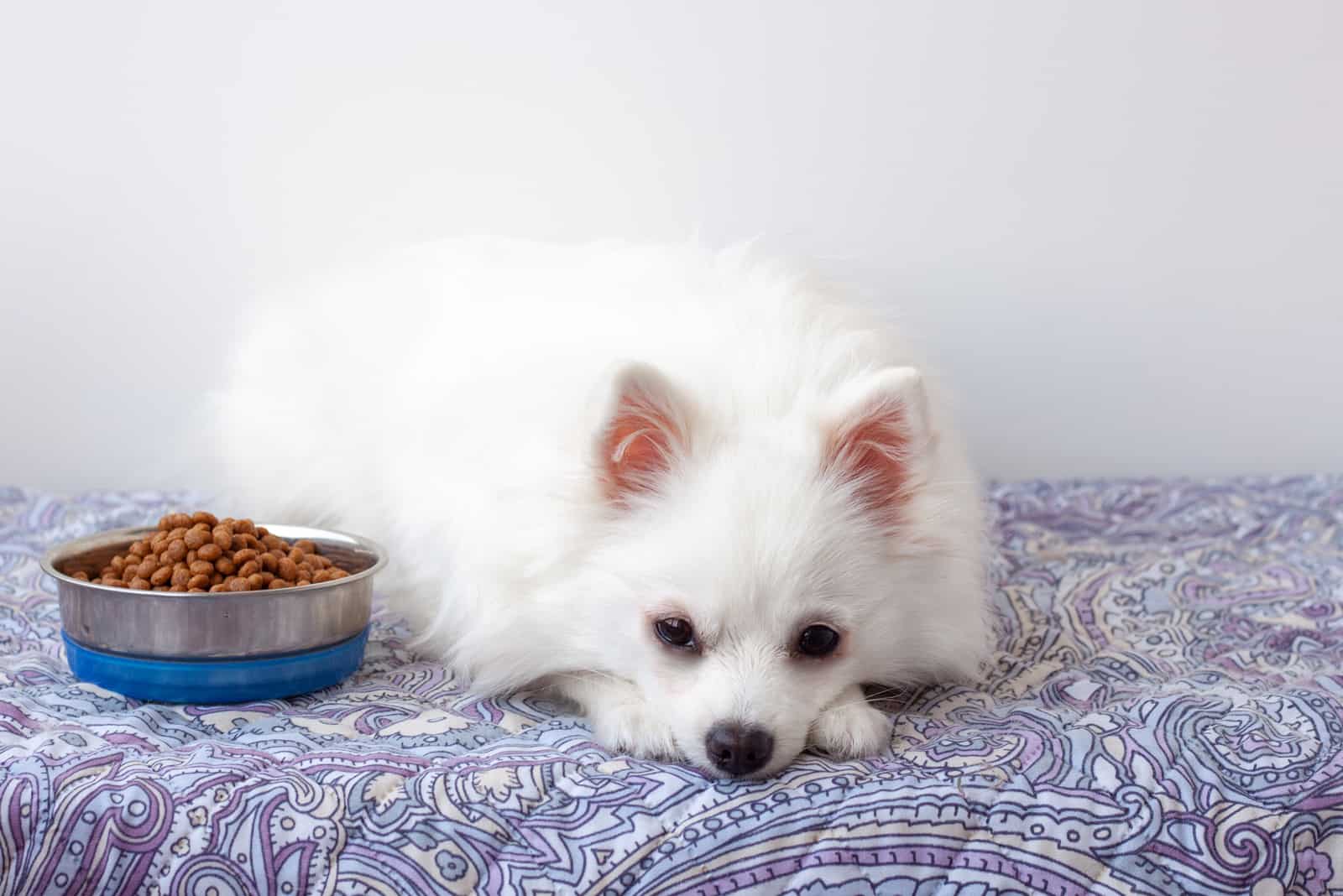
The first thing you have to do is probably the most obvious one. Check the expiration date on the back of the dog food can or bag of kibble. It’s not uncommon for such products to be sold past their expiration date. It’s an honest mistake that can happen to anyone.
To be honest, we rarely check expiration dates, even though we should.
If everything seems to be alright with your dog’s food, let’s move on!
You should stimulate your dog’s appetite by pouring delicious sauces or toppers on top of the kibble.
I remember my mom used to put canned sardines on top of our dog’s food occasionally. It was good for his coat and skin, and it gave a spectacular flavor. I remember Zeus devouring the entire meal every time!
If that doesn’t work, try sticking around until your dog eats. Some dogs seem to function better around people. It’s not uncommon for pups to demand attention even during mealtime. Still, I’d be careful around any dog breed while they’re eating since dogs can show food aggression.
If it’s not the dog’s appetite or fussiness, it’s time to report this behavior to your chosen vet. After a detailed checkup, your vet will be able to figure out whether your dog is having a chronic condition that keeps him from eating his meals, or something minor.
How Do You Make Your Dog Start Eating Again?
The first thing that comes to every dog owner’s mind is: should I try to make my dog’s food more delicious?
I mean, it’s dog food – how delicious can it be?
Well, our canine buddies have taste buds, too. They know when something’s yummy and when it’s not. Usually, dry kibble is not that appetizing. It’s a good choice for growing puppies because it helps with their jawline development, but it’s hard to chew it.
That’s why many dog owners mix dry kibble with some warm water. It becomes a mushy mash, but it’s apparently delicious for pups!
It’s not recommended for adult dogs to eat kibble this way. What you can do is add dog food toppers that will enhance the flavor of the formula. Lately, I’ve seen many brands coming up with their own food toppers, and I approve of this new movement.
Is Leaving Dog Food In The Bowl Okay?
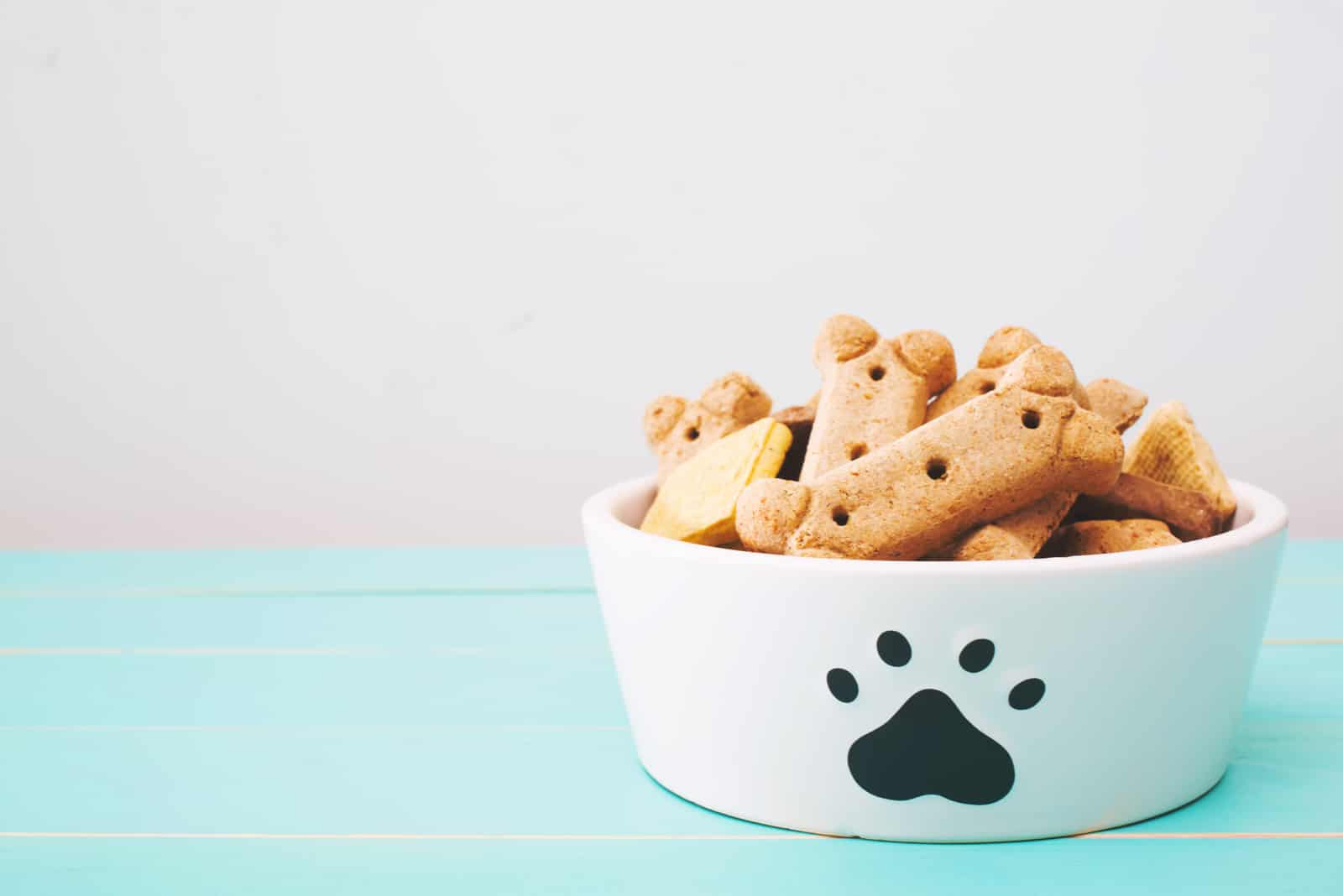
Being a fussy eater, your dog has probably tried nibbling on its meal, and then leaving it like that for hours.
According to your feeding schedule, it’s time for another meal, but your dog hasn’t touched its first serving at all. What just happened? Was leaving the food in the bowl a good practice? Did the food go… bad?
It’s quite possible that your dog has tried its meal and decided he wasn’t feeling hungry at the moment. When the right moment came by, the said meal was tasting or smelling funny. It’s highly likely that wet food left at room temperature, or outside when it’s too hot, has gone bad.
In such cases, don’t blame your dog for refusing to eat. You should know better. Food must not be left at room temperature for longer than two hours. After this period of time, bacteria starts to grow and may even lead to severe contamination.
Instead of leaving your dog’s wet food outside, waiting for your dog to eat it, offer it and place the remains in a sealed container back in your fridge. You’ll avoid the food getting spoiled, and the unnecessary waste of money and dog cans.
Dry dog kibble can’t go bad that easily like wet dog food. Still, I wouldn’t recommend it to stay outside for too long. Free feeding dogs should never be an option no matter the type of food they’re eating.
You can’t track how many bits of kibble your dog has eaten. Also, you’re not enforcing the right eating habits. We’ll discuss them down the road.
Should I Feed My Dog A Second Choice Of Food?
A second choice of dog food depends on your dog’s condition. Do you have a healthy dog that has just got a lack of appetite, or an ill fellow with some medical issues.
If your dog is actually sick, consult your vet. Some may say you can offer chicken broth or wet food that has been watered down. These are fine options, but I wouldn’t do anything without consulting my vet first. You never know what kind of gastrointestinal health problems broth may cause, especially store-bought ones.
Ill dogs need fluids, so give them lots of water and the proper medications that will restore lost energy, vitamins, and salts.
On the other hand, doggos that simply don’t want to eat may strike because they don’t like that specific formula. This usually happens if you’re feeding your dog something new.
Just recently, I switched from one specific dog food brand to another because I had hard times finding it in stock. Even though I compared the formulas and they seemed pretty much the same, my dog refused to eat. There was something in that new dry dog food that my pup hated.
Read Next: What Are The Worst Dog Food Brands On the Market?
Luckily, a friend of mine helped me find some kibble that my dog likes, so we’re stocked up once again.
If you’re in the same predicament as I was, switching immediately to a new food isn’t a good idea. Let the transition go gradually. Switch one portion of your dry food with the new formula over several days, so you end up with a whole meal consisting of the new food.
I guarantee, once your dog accepts at least a bit of the new kibble, he will never remember the old food.
I want to point out that if your dog refuses his pet food, don’t try feeding him human food or table scraps. That’s something that leads to bad habits – most importantly, unhealthy habits.
What Is Partial Anorexia With Dogs?
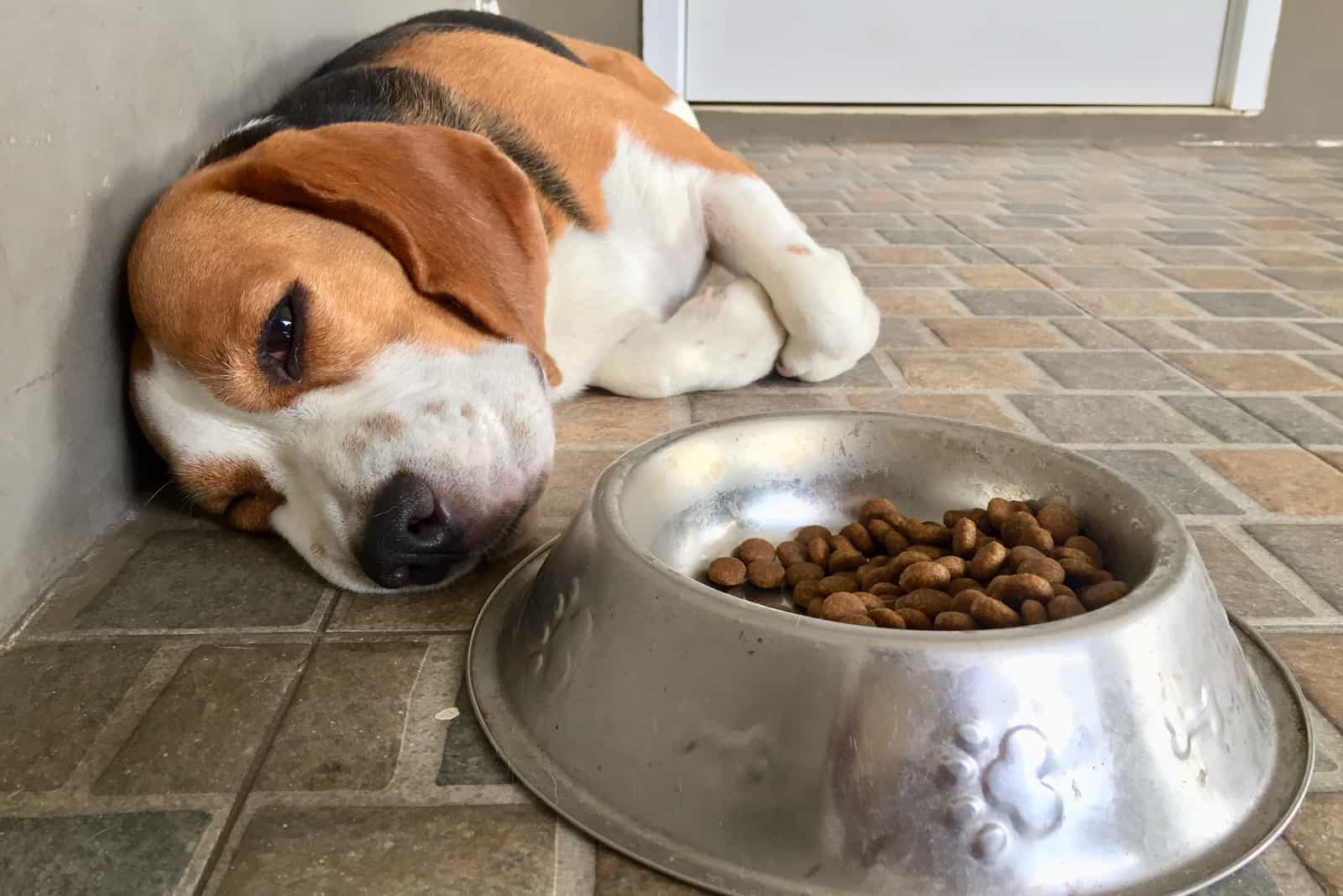
Partial anorexia with dogs is something that not all of us have heard of before. Frankly, I was really surprised to hear that such a condition exists.
Did you know that there’s a name for the condition of avoiding one food and eating only one type? In fact, it covers all picky eaters and their behavior. In other words, when a dog prefers only one type of food or one ingredient over everything else, that’s called partial anorexia.
This condition is not as severe as actual anorexia, but it still has to be treated.
The difference between the two anorexic conditions is that dogs with partial anorexia at least eat something.
Still, this is not healthy. Dogs with partial anorexia can trigger all sorts of problems. Weight loss is just the beginning. Where are cardiac issues? How about ulcers, anemia, and kidney and liver failure? All sorts of problems can come out of partial anorexia, and we’ll discuss them soon.
Actual anorexia usually has deeper roots of these problems, while partial can be solved with your or your vet’s intervention.
Health Issues That Will Cause Loss Of Appetite With Dogs
Health reasons are, sadly, the biggest reasons why your dog may refuse food and pick small treats instead.
Usually, dogs suffering from an upset stomach will find their relief in medicine or it will simply go away once the dog poops. But, what if not? What are some severe reasons why dogs won’t eat their food?
Dental Issues
It’s not uncommon for dogs to have issues with dental diseases. A dog’s mouth is not the cleanest place on Earth. Most often, dogs will experience some sort of dental problems, i.e., sensitive gums or cavities.
To prevent these issues, brush your dog’s teeth. I recommend you do this task daily. Let your vet treat cavities and infections before they turn into severe infections that may cost your dog its teeth.
Kidney Diseases
Kidney diseases could be chronic or acute. Believe it or not, they’re one of the reasons behind partial anorexia.
Fortunately, kidney conditions are fairly easy to detect. The first symptom is excessive thirst. Your dog will drink lots and lots of water, but the number of urinations per a day will remain the same, or even drop down a bit.
Also, dogs suffering from kidney conditions will have visible ulcers inside their mouth. This will result in terrible breath, as well as depressive behavior.
Neurologic Diseases
Sadly, dogs can suffer from conditions that will affect their neurologic system, including their spine, brain, and nerves.
These conditions can cause all sorts of problems with the dog’s mobility. But, that’s not all! Neurologic issues can also lead to appetite loss. I won’t mention other conditions in detail, such as brain tumors or epilepsy.
Liver Diseases
Are you aware of the real function of the liver? It’s an organ that clears your dog’s body and frees it from all the toxins and waste. Any liver problem will cause toxins to build up, and this may lead to liver failure.
Liver issues can show symptoms like lethargy, throwing up, and doggy diarrhea. A lack of appetite is a drop in the sea of liver issues.
Pancreatitis
Pancreatitis, or any other pancreas-related issue, can cause partial dog anorexia. This is a severe condition that requires immediate veterinary help. Since pancreatic cancer and pancreatitis both have appetite loss as a common symptom, you should be careful around the first signs of hunger strike.
Gastrointestinal Diseases
The dog’s GI tract starts from the dog’s mouth, and moves on to the esophagus, the small intestine, and the large intestine. Any of these organs can be affected by worms or infections. Usually, dogs get affected by roundworms, whipworms, and viruses like parvovirus.
Also, ulcers can cause additional GI problems, and may scare your pup away from eating his meals.
Blood Conditions
Blood conditions like dog anemia are pretty common and stubborn to treat. You will need to stay persistent and keep on the treatment until blood work is finally within normal ranges.
Besides general weakness and lethargic behavior, anemia can cause severe weight loss. Until you treat it, you can’t expect any significant breakthrough with your dog’s appetite or weight gain.
Learn more on weight gain in our article on how long does it take for a dog to gain weight.
Lung Diseases
Infections can strike a dog’s airways that causes loss of scent, which makes dogs lose their appetite. I mean, how many times have you lost your scent because you were feeling under the weather?
The same thing happens to dogs. When they can’t smell their food, they won’t eat it. It’s as simple as that. On the other hand, they connect treats with happy feelings. They recognize their shape, and even the bag they come in. So, that’s why your dog won’t eat his food, but will eat treats!
How Do You Prevent A Hunger Strike?
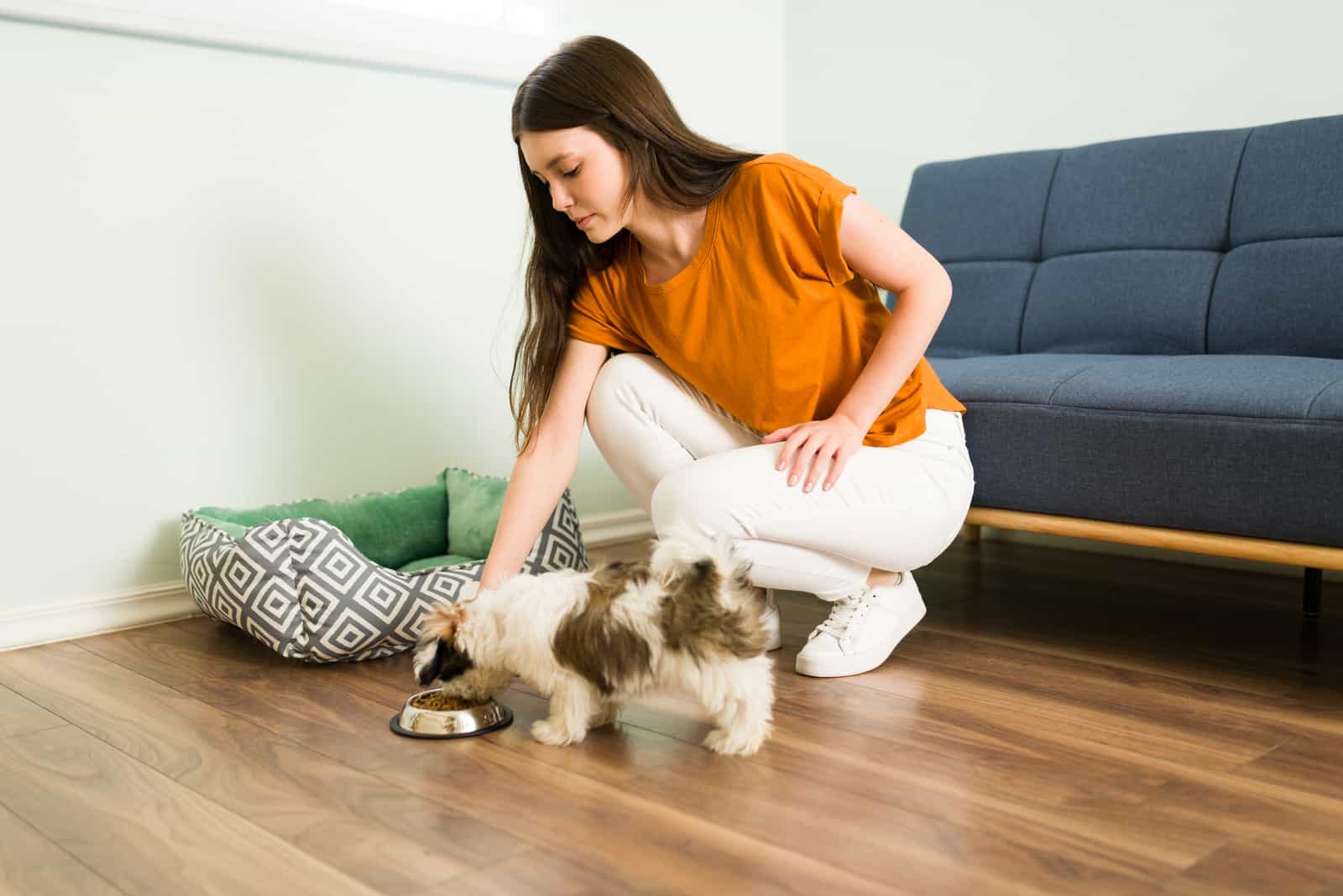
A food strike is something you can prevent if you devote yourself completely to it. The only way this is possible is by strictly monitoring your dog’s diet.
But, your dog’s diet isn’t the only thing that needs to be monitored. Watch your dog’s behavior, too! Watch situations that may cause stress for your dog. They all can affect changes in his behavior, and cause your dog to stop eating his meals and pick treats instead.
A loss of appetite, if it’s not medically conditioned, can be fixed rather quickly.
For example, if your dog has gone into the trash and found something bad, the achy stomach can be solved with some medications. You’ll know better the next time you see your pup roaming through the trash.
Food strikes can be prevented if you spot the first signs of your dog disliking your chosen kibble or canned food, depending on your preferences. Maybe the kibble is too dry for him. Maybe your pooch prefers wet food. Or, maybe he’s simply a picky eater like human toddlers.
Switch the formula before the dog refuses to eat.
Lastly, I want to stress something that most dog owners don’t understand. Treats aren’t necessarily good for your dog. If you limit them, you’ll see how your dog will devour his meals. Dogs, even though they’re considered adults, are just big babies.
Think of them as spoiled toddlers. A toddler won’t even eat food off his plate if it’s not pretty enough. Dogs can dislike their food bowls, too! It’s the little things that truly bother them, but we end up busting our heads trying to realize what’s wrong with our four-legged buddies.
Creating Proper Eating Habits For Your Dog
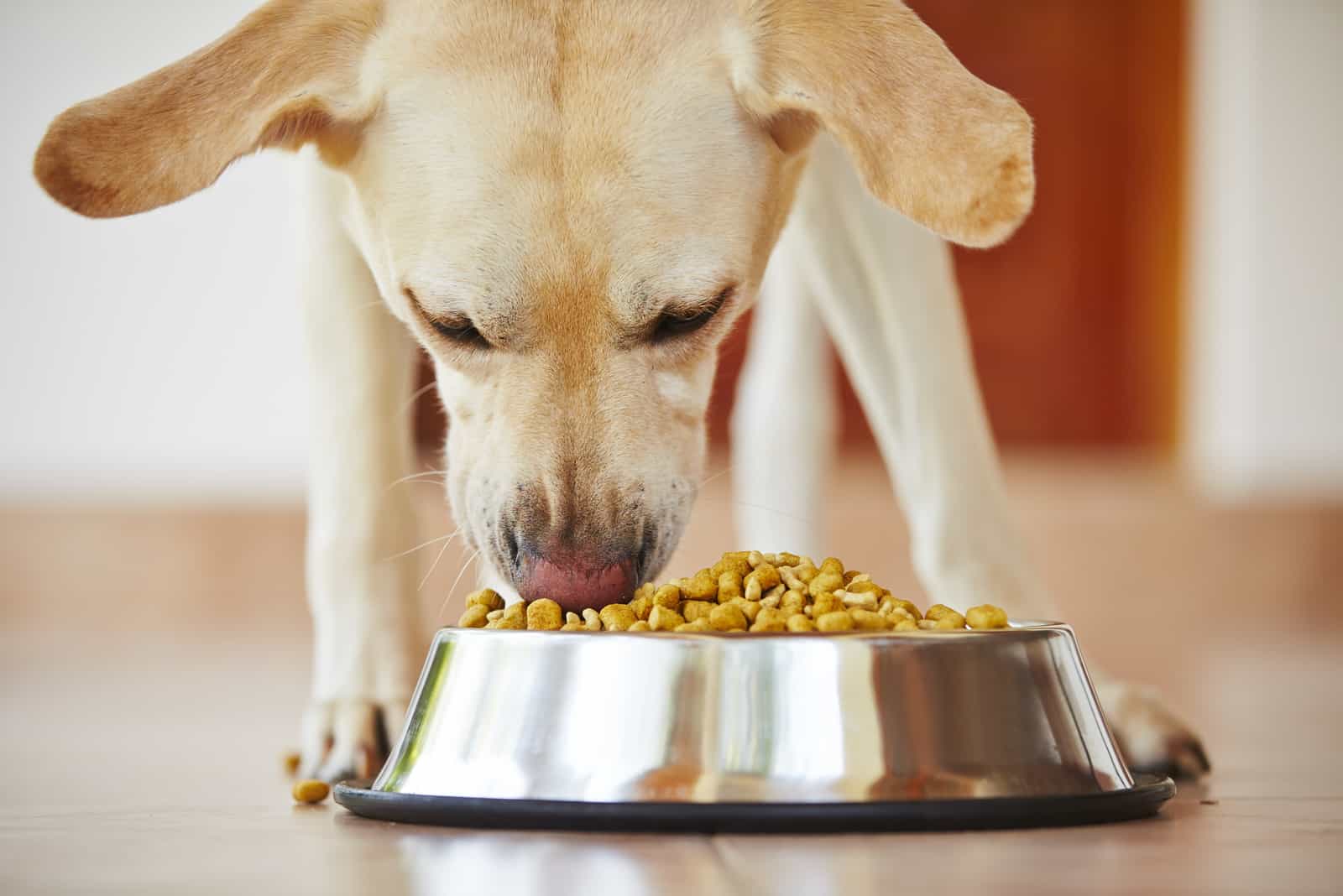
Every dog owner must enforce healthy habits for their new pet. This means not only good eating habits, but also exercising regularly.
I feel like we’re talking about humans today, but picky dogs aren’t that different from picky humans. Let’s face it: we all eat junk food from time to time, and we refuse to feed ourselves the healthy way just because we can.
However, be a pet owner who will serve as an example. If you’re getting a puppy from a breeder, he’s still a baby. They’re usually put up for adoption around two months of age. This is the period when they start eating regular food and stop depending on their mommy’s milk.
Once you show your puppy when it is mealtime and what the dish of the day is, he will learn it and adopt that habit. Puppies don’t know differently. They only know what you teach them.
Your pooch should have around four meals a day until he becomes an adult. Adult and senior dogs usually have two meals a day – in the morning and in the afternoon.
Make sure you stick to the feeding schedule, and don’t serve meals outside of it.
I encourage you to use treats only when you must. Treats should help our pups learn tricks faster. But, praises also work well, so control the treat intake. It should not go over 10% of the total food intake. I mean, one of the most common reasons for obesity is excessive intake. Don’t let that happen.
Human Food As Treats
Some veterinary advice I once got: if you really want to give your dog treats, try some human food like fruits and veggies.
Truth be told, most doggy snacks on the market are packed with fillers, and don’t really have many healthy ingredients. Isn’t broccoli a better choice? How about bell peppers?
There’s a long list of do’s and don’ts concerning human food for dogs.
Here’s what your dog should never eat:
onions
garlic
chocolate
spicy food , i.e., paprika or jalapenos
processed food like spam , vienna sausages , etc.
The list of allowed human food for dogs may surprise you because your pooch can have some:
broccoli
apples
blueberries
sweet potatoes
plantains, etc.
Remember, the allowed foods are only okay in a moderate amount. You should not base your dog’s diet by only using the listed ingredients. Sure, a raw diet is fine as long as you use real animal proteins and make them dominant over other ingredients. For more information, check our article on this topic to find out how much raw food to feed your dog.
Conclusion
I hope you’re clear now on why your dog won’t eat his food, but will eat treats.
This uncommon behavior isn’t something you should take for granted.
If you notice the first signs of your dog refusing food, you should react immediately. Most reasons behind this behavior will require your vet’s assistance, but still try to exclude some common issues that you can solve on your own.
Who knows – maybe that specific brand of kibble isn’t working for your dog anymore? Maybe he’s just not hungry at the moment. Give your dog some time. If he still refuses to eat, and picks treats whenever you offer him some, then it’s time to intervene.
Cut down treats. Force healthy habits and proper meals. Lastly, let your vet perform a thorough examination of your dog.
I really hope the reason why your dog is behaving this way is because of some minor reasons that can be solved easily. The last thing I’d want for you and your dog is to have a condition that must be addressed immediately.
Read Also: Helpful Tricks For How To Stop Dog From Eating Cat Food
